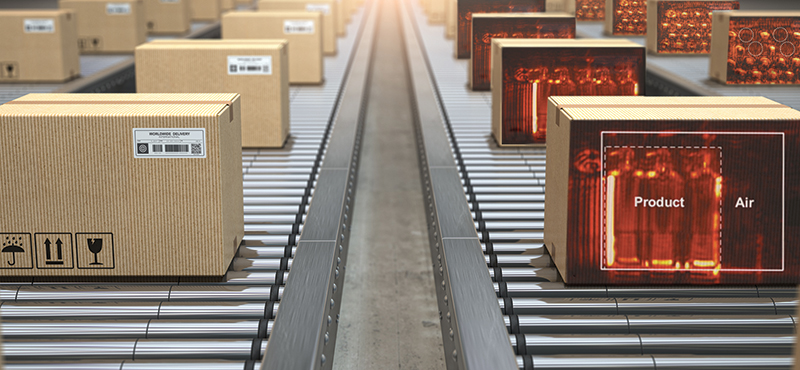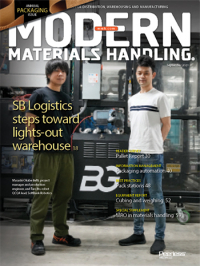Cubing and Weighing: Right on the money
Cubing and weighing equipment helps companies make better use of their warehouse space, cut shipping costs and reduce errors.
Physical space constraints, rising transportation rates and carrier surcharges are just some of the reasons why companies are sharpening their cubing and weighing pencils right now. Add the double-digit e-commerce sales increases and a bigger focus on environmental sustainability to the equation (for example, no one wants to ship or receive a tiny item packed in a huge box), and it’s no secret why equipment that captures accurate item dimensions and weight is playing a leading role in many warehouses and DCs.
Cubing systems use laser, camera, ultrasonic or infrared sensing equipment to capture an item’s accurate dimensions, while weighing equipment basically does what it says it does: provides accurate measures of an item’s weight.
Used separately or together, these dimensioning systems also measure irregular shapes, detect anomalies and gather inventory data about goods from the time they arrive in the warehouse until they are delivered to the final customer.
When UPS, FedEx, and the U.S. Postal Service changed the way they assess shipping charges about four years ago, demand for dimensioning systems grew exponentially. Rather than using weight to make their assessments, these carriers began using dimensional weight (dim weight) as a measure. They multiply the three dimensions of the package (the “total package volume”) and divide it by a factor to arrive at that dim weight number. Carriers then determine shipping charges based on that number.
Cubing and weighing equipment also plays an important role in fulfillment facilities, where knowing the inventory’s size and weight translates into great visibility for the operation and more efficient use of space. This not only helps companies avoid shipping empty packages, but it also helps optimize their physical distribution space—an important win for operations now managing higher volumes of e-commerce orders within their existing physical footprints.
Upfront cartonization
At a fundamental level, Dan Hanrahan, CEO at Numina Group, says cubing equipment is most often used for parcel manifesting. However, companies have also started using it for intelligent order release based on cartonization.
Armed with the correct data about a package’s dimensions, contents and weight, companies can select the best carrier, shortest ship time and lowest shipping cost. Hanrahan calls this the “pack class,” and says it includes the actual package type along with its weight and dimensions.
More companies are also using upfront cartonization with the goal of calculating in advance what the items are, how big they are, what they weigh, what’s going into a specific order, and exactly how it will be shipped. So, rather than leaving these details until the order is picked, packed and shipped, companies are using technology to more accurately estimate shipping costs right at the point of order entry.
That way, neither the customer nor the company is surprised when shipping costs are higher than expected or when an order doesn’t meet the requirements for free shipping. Upfront cartonization that includes all master weights and dimensions for products also gives customers more shipping choices and cuts down on guesswork.
“Companies want to see the cost to move a delivery from ground to two-day air before that order is even fulfilled,” says Hanrahan. For those organizations, Numina is developing and integrating technology that helps them more accurately “upfront calculate” their actual costs based on data versus just ballpark estimates.
Catching problems at the source
Many companies don’t even realize that hidden problems in item-level data can create increased cost across their operations. For example, missing or inaccurate SKU-level dimensions in a master database may misrepresent just how full automated storage and retrieval system (AS/RS) totes and outbound packages really are and result in hidden inefficiencies.
Dimensioning equipment helps companies improve item-level data and avoid those added costs. For example, ThruWave’s 3DmmWave imaging system can audit all outgoing packages by scanning inside and showing just how full AS/RS totes and packages really are, according to Pieter Krynauw, CEO of ThruWave. “Instead of relying on a database with outdated information,” he says, “dimensioning and cubing can be measured in real time on every tote or outbound package and include information on content variables inside.”

Dimensioning equipment also helps identify and report on trends that can quickly become hidden cost centers for warehouse operators. For example, when an employee selects the incorrect box size or packaging, it translates into waste and inefficiencies. Multiply this by thousands of orders and the cost and waste can be substantial, but also avoidable.
“Data gathered by the ThruWave system can tie back to monitor how associates are doing and identify trends like choosing the wrong box,” says Krynauw.
For operators that need to improve packaging efficiency, optimize outbound shipping costs and reduce carbon footprint, the system can provide automated inspections. Unlike traditional cubing and dimensioning equipment that measures outside visible dimensions of items, the system “sees” inside of sealed boxes.
Using millimeter wave sensors, the equipment detects and measures both the container and contents, providing the actual fill fraction/cube utilization of totes and outbound packages.
The 3D mmWave imaging system enables real-time dimensioning and cube utilization measurement, even when items are obscured by containers. “Our sensors see through sealed cardboard packages and plastic totes,” says Krynauw, “to detect and dimension items in motion in real-time at conveyor speeds of up to 600 feet per minute.”
Know what you’re measuring
Breaking down the various categories of dimensioning equipment,Cubiscan’s director of sales and marketing Dean Simmons says the options include ultrasound (mainly used for boxes because it requires a perpendicular surface), time-of-flight dimensioners that use 3D cameras, and lasers.

“Lasers cost the most, but are also the most accurate,” says Simmons, who has seen increased demand for camera-based pallet dimensioners—a product Cubiscan began making this year, but with a few caveats. For example, he says the products struggle when used with black plastics or dock sweat/slippage. “Camera dimensioners also need almost perfect orientation in the measurement area,” Simmons explains, “and they can’t always [detect] protrusions sticking out of the freight, but that you’ll still be charged for.”
To companies that are shopping for cubing and dimensioning equipment this year, Simmons says “know what you’re measuring.” More specifically, get an understanding of the types of items you’re shipping or storing; their min/max measurement and weight ranges; and how they’re packaged (for example: boxed, unboxed, flat packs, etc.). “Be clear on what you need measured,” Simmons reinforces, “and the desired outcome of that measurement.”
For example, some companies may need to know the actual contour of the point cloud (a set of data points in space) of a specific item. Others need the maximum length, width and height measurement of the bounding box, or an imaginary rectangle that surrounds an object and specifies its position.
“If a company needs point cloud or acute measurements, that will significantly impact the type of dimensioner that it selects,” says Simmons.
Looking ahead, Simmons sees handheld devices playing a bigger role in the dimensioning space, but warns companies about the devices’ potential limitations and possible misinformation being shared in the market right now. “Handhelds seem to be a real buzzword right now; customers talk about them a lot because they think handhelds will be more efficient,” says Simmons, who adds that Cubiscan is working on its own handheld options right now.
“What companies tend to forget is that a handheld measurement requires someone to walk all the way around a piece of freight to measure it correctly; the handheld device can’t ‘see through’ that freight,” Simmons points out. “So where handhelds are neat futuristic solutions, there’s still some work to be done on them.”
The right match
To get the best match between available cubing and weighing equipment and a warehouse’s operational needs, Hanrahan advises a full audit of all shipment types, product shapes and other parameters that come into play in the fulfillment, storage and shipping process. Come up with a list of vendors and then ask them the right questions, knowing that myriad options are available on the market and not all of them will align with your company’s specific needs.
“You want a measurement system that adapts to the full scope of products that you’re shipping, and getting there requires some legwork,” says Hanrahan. “This isn’t a ‘buy it off the shelf at the lowest price’ kind of decision. Make sure the technology that you’re investing in can cover the full range of products that you’re going to be shipping.”

Article Topics
Packaging News & Resources
Registration open for Pack Expo International 2024 Pack Expo East has largest show to date Optimize Parcel Packing to Reduce Costs CMC Packaging Automation North America unveils Tech Center in Atlanta PACK EXPO East brings latest packaging technologies to Philadelphia Loftware’s cloud-based labeling solutions take center stage Flexcon unveils its innovative bin solutions More PackagingLatest in Materials Handling
Beckhoff USA opens new office in Austin, Texas Manhattan Associates selects TeamViewer as partner for warehouse vision picking ASME Foundation wins grant for technical workforce development The (Not So) Secret Weapons: How Key Cabinets and Asset Management Lockers Are Changing Supply Chain Operations MODEX C-Suite Interview with Harold Vanasse: The perfect blend of automation and sustainability Consultant and industry leader John M. Hill passes on at age 86 Registration open for Pack Expo International 2024 More Materials HandlingAbout the Author
Subscribe to Materials Handling Magazine

Find out what the world's most innovative companies are doing to improve productivity in their plants and distribution centers.
Start your FREE subscription today.
April 2024 Modern Materials Handling

Latest Resources












